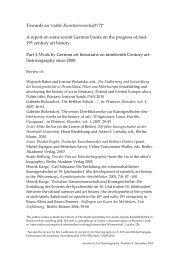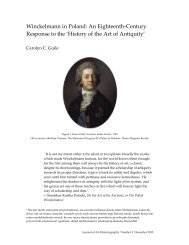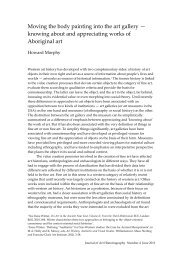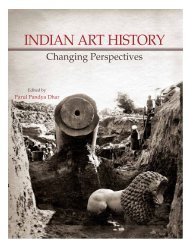The advantages and disadvantages of Art History to Life: Alois Riegl ...
The advantages and disadvantages of Art History to Life: Alois Riegl ...
The advantages and disadvantages of Art History to Life: Alois Riegl ...
You also want an ePaper? Increase the reach of your titles
YUMPU automatically turns print PDFs into web optimized ePapers that Google loves.
problem went far beyond the terms <strong>of</strong> the previous debate. He not only helped <strong>to</strong> put<br />
the final nail in<strong>to</strong> the c<strong>of</strong>fin that was his<strong>to</strong>ricism at the Museum, but in doing so, he also<br />
challenged the basic presuppositions <strong>of</strong> the institution <strong>and</strong> the scholarly culture <strong>of</strong> art<br />
his<strong>to</strong>ry in Vienna <strong>and</strong> beyond.<br />
II. A his<strong>to</strong>ry <strong>of</strong> renaissances<br />
<strong>Riegl</strong>’s lengthy essay appeared in three instalments in the Austrian Museum’s journal<br />
(Mittheilungen des österreichischen Museums für Kunst und Industrie) in early 1895. 9 It<br />
began harmlessly enough. In the first two sections <strong>Riegl</strong>, ever the his<strong>to</strong>rian, presented a<br />
general overview <strong>of</strong> artistic renaissances <strong>of</strong> the past. It was, after all, the goal <strong>of</strong> the<br />
Museum <strong>to</strong> foster an artistic renaissance in the present. What better way <strong>to</strong> begin than <strong>to</strong><br />
evaluate the key events <strong>of</strong> the past?<br />
He began by examining three significant artistic renaissances in Western Europe:<br />
the Carolinginan Renaissance, the ‘pro<strong>to</strong>-Renaissance’ <strong>of</strong> the twelfth century, <strong>and</strong> the<br />
Italian Renaissance. This careful analysis lasted for about twenty pages <strong>and</strong> we can<br />
summarize it by saying that on the basis <strong>of</strong> these three ‘renaissances’ <strong>Riegl</strong> concluded<br />
that a genuine renaissance contained several common elements. Regardless <strong>of</strong> their<br />
geographical or temporal distance from one another, artists <strong>and</strong> craftsmen in all three<br />
epochs shared the same qualities: a dissatisfaction with contemporary art (for one<br />
reason or another), a recognition <strong>of</strong> a superior style somewhere in the past (Roman<br />
antiquity in all three instances), <strong>and</strong> a happy confidence (without awe) in their ability <strong>to</strong><br />
draw from this source <strong>and</strong> adapt it for contemporary use. <strong>Riegl</strong> called this last quality<br />
the unbefangene Auge—the unfettered eye. Renaissance artists, whether from the ninth,<br />
twelfth, or fifteenth century, all turned <strong>to</strong> the past for inspiration, but did not let the past<br />
dominate their present: ‘With their gazes trained steadily forward, the artists <strong>of</strong> all three<br />
Renaissances ... never considered it necessary or important <strong>to</strong> res<strong>to</strong>re the styles <strong>of</strong> the<br />
past.’ 10 For a genuine renaissance <strong>to</strong> occur, <strong>Riegl</strong> concluded, the artist must adapt, not<br />
copy, the past in a spirit <strong>of</strong> confidence <strong>and</strong> joy. Freedom from his<strong>to</strong>ry was a common<br />
characteristic <strong>of</strong> renaissance artists <strong>and</strong> adaptation was their goal.<br />
Cura<strong>to</strong>rs at the Museum for <strong>Art</strong> <strong>and</strong> Industry believed this <strong>to</strong> be true about<br />
themselves, (they ‘adapted’ but did not copy the Italian Renaissance designs, for<br />
example), but <strong>Riegl</strong> was not so sure. For him, there was really no national difference<br />
between the Germans <strong>and</strong> his colleagues at the Museum. In both locations their shared<br />
reliance on his<strong>to</strong>ricism ruined the naïve relationship <strong>to</strong> the past necessary for a true<br />
renaissance. His conclusion was provocative: Everyone had been wrong about how <strong>to</strong><br />
effect a renaissance in contemporary design. His<strong>to</strong>ricism in the applied arts had<br />
universally failed <strong>to</strong> produce an artistic renaissance:<br />
9 <strong>Alois</strong> <strong>Riegl</strong>, ‘Über Renaissance der Kunst’, MÖM N.F. V (1895), 342-48;363-71; <strong>and</strong> 381-93.<br />
10 <strong>Riegl</strong>, ‘Renaissance’, 369. ‘Die Künstler aller drei Renaissancen haben eben den Blick stets vorwärts gewendet<br />
gehabt, . . . und sie hielten es . . . nicht für nötig, alte, vergangene Stilweisen dem Wesen nach zu restauriren’.<br />
4
















